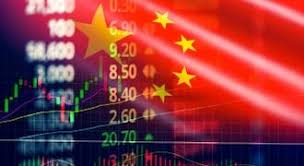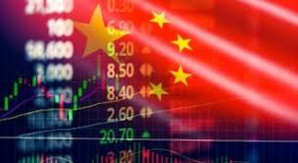The Chinese economy exhibited unexpected resilience in August, with faster-than-expected growth in factory output and retail sales bolstering a fragile recovery, but a deepening property slump weighed on the outlook.
The better-than-expected figures indicate that the world's second-largest economy is gaining traction, having narrowly avoided a contraction in the June quarter and lifting recovery prospects for the rest of the year.
According to the National Bureau of Statistics, industrial output increased 4.2 per cent year on year in August, the fastest rate since March (NBS). This was higher than the 3.8 per cent increase predicted by analysts in a Reuters poll and the 3.8 per cent increase in July.
Retail sales increased 5.4 per cent year on year, the fastest in six months and exceeding forecasts of 3.5 per cent growth and 2.7 per cent growth in July.
"This is due to a lower base for comparison – the Delta wave was weighing on economic activity in August 2021," said Julian Evans-Pritchard, a China economist at Capital Economics.
Although the positive data lifts some of the gloom that had been hanging over the sluggish recovery due to weak trade data and slow credit growth, Evans-Pritchard does not expect the strength to last into September.
"And while the current virus wave may have peaked, activity is set to remain weak over the coming months amid the deepening property downturn, softening exports and recurring COVID-19 disruptions," he said.
The auto industry was a major contributor to both factory output and retail sales, with new energy vehicle production increasing 117 per cent, aided by government incentives for cleaner vehicles.
However, outages at several state and independent oil refineries, as well as thinning margins, kept crude throughput near two-year lows. Daily coal output fell to a three-month low.
With few signs that China will significantly ease zero-COVID any time soon, some analysts predict the economy will grow at a rate of 3 per cent this year, the slowest since 1976, excluding the 2.2 per cent expansion during the initial COVID hit in 2020.
"Since the start of this year, the situation facing economic development has become more complex and severe than that in 2020," NBS spokesperson Fu Linghui said, citing the risk of a global downturn and challenges around China's COVID controls. However, he said recent policy support was having some effect.
In contrast to the positive activity data, the property sector contracted further in August, with home prices, investment, and sales all continuing to decline.
According to Reuters calculations based on official data, property investment fell 13.8 per cent last month, the fastest rate since December 2021.
New home prices fell 1.3 per cent year on year in August, the fastest drop since August 2015, and followed a 0.9 per cent drop in July.
China's property market, once a key driver of economic growth, has lurched from crisis to crisis since mid-2020, when regulators intervened to limit developers' excess leverage.
Property woes have weighed heavily on the world's second-largest economy, and policymakers are now scrambling to avoid a prolonged downturn.
Companies are wary of expanding and hiring more workers in the face of low consumer and business confidence. The nationwide survey-based unemployment rate fell slightly to 5.3 per cent in August, down from 5.4 per cent in July. After reaching a record 19.9 per cent in July, youth unemployment remained high at 18.7 per cent.
Since late May, policymakers have announced over 50 economic stimulus measures, emphasizing that this quarter was critical for policy action. more info
However, rapid declines in the yuan against the US dollar have worried policymakers, complicating the case for looser monetary support.
On Friday, the yuan fell below the psychologically important 7 per dollar level for the first time in two years, weighed down by a strong dollar and market expectations for an even more aggressive U.S. interest rate hike next week.
According to Bruce Pang, chief economist at Jones Lang Lasalle, China's central bank will not cut interest rates in the near future.
Instead, easing could come in the form of liquidity measures, as well as support for manufacturing and green investment.
"Other policy options, including a reserve requirement ratio cut, remain on the table," Pang said.
Others anticipate a reduction in the benchmark loan prime rate as a result of China's large banks lowering deposit rates, which could relieve margin pressure. more info
To stimulate growth, authorities have resurrected an old strategy, issuing debt to fund large public works projects. According to Friday's data, infrastructure investment increased 8.3 per cent year on year in the first eight months, up from 7.4 per cent in January-July.
On Tuesday, Premier Li Keqiang presided over a cabinet meeting that announced extended tax relief for small businesses as well as an additional 200 billion yuan lending quota for the manufacturing and social services industries.
Analysts anticipate more disruptions from tighter COVID controls in September, ahead of the ruling Communist Party's Congress, which begins Oct. 16 and in which President Xi Jinping is expected to break with precedent and secure a third leadership term.
A new economic leadership team, which is expected to take over next year, will face a number of challenges, including how to undo what many see as an unsustainable zero-COVID policy, the property crisis, and tensions with Washington.
(Source:www.reuters.com)
The better-than-expected figures indicate that the world's second-largest economy is gaining traction, having narrowly avoided a contraction in the June quarter and lifting recovery prospects for the rest of the year.
According to the National Bureau of Statistics, industrial output increased 4.2 per cent year on year in August, the fastest rate since March (NBS). This was higher than the 3.8 per cent increase predicted by analysts in a Reuters poll and the 3.8 per cent increase in July.
Retail sales increased 5.4 per cent year on year, the fastest in six months and exceeding forecasts of 3.5 per cent growth and 2.7 per cent growth in July.
"This is due to a lower base for comparison – the Delta wave was weighing on economic activity in August 2021," said Julian Evans-Pritchard, a China economist at Capital Economics.
Although the positive data lifts some of the gloom that had been hanging over the sluggish recovery due to weak trade data and slow credit growth, Evans-Pritchard does not expect the strength to last into September.
"And while the current virus wave may have peaked, activity is set to remain weak over the coming months amid the deepening property downturn, softening exports and recurring COVID-19 disruptions," he said.
The auto industry was a major contributor to both factory output and retail sales, with new energy vehicle production increasing 117 per cent, aided by government incentives for cleaner vehicles.
However, outages at several state and independent oil refineries, as well as thinning margins, kept crude throughput near two-year lows. Daily coal output fell to a three-month low.
With few signs that China will significantly ease zero-COVID any time soon, some analysts predict the economy will grow at a rate of 3 per cent this year, the slowest since 1976, excluding the 2.2 per cent expansion during the initial COVID hit in 2020.
"Since the start of this year, the situation facing economic development has become more complex and severe than that in 2020," NBS spokesperson Fu Linghui said, citing the risk of a global downturn and challenges around China's COVID controls. However, he said recent policy support was having some effect.
In contrast to the positive activity data, the property sector contracted further in August, with home prices, investment, and sales all continuing to decline.
According to Reuters calculations based on official data, property investment fell 13.8 per cent last month, the fastest rate since December 2021.
New home prices fell 1.3 per cent year on year in August, the fastest drop since August 2015, and followed a 0.9 per cent drop in July.
China's property market, once a key driver of economic growth, has lurched from crisis to crisis since mid-2020, when regulators intervened to limit developers' excess leverage.
Property woes have weighed heavily on the world's second-largest economy, and policymakers are now scrambling to avoid a prolonged downturn.
Companies are wary of expanding and hiring more workers in the face of low consumer and business confidence. The nationwide survey-based unemployment rate fell slightly to 5.3 per cent in August, down from 5.4 per cent in July. After reaching a record 19.9 per cent in July, youth unemployment remained high at 18.7 per cent.
Since late May, policymakers have announced over 50 economic stimulus measures, emphasizing that this quarter was critical for policy action. more info
However, rapid declines in the yuan against the US dollar have worried policymakers, complicating the case for looser monetary support.
On Friday, the yuan fell below the psychologically important 7 per dollar level for the first time in two years, weighed down by a strong dollar and market expectations for an even more aggressive U.S. interest rate hike next week.
According to Bruce Pang, chief economist at Jones Lang Lasalle, China's central bank will not cut interest rates in the near future.
Instead, easing could come in the form of liquidity measures, as well as support for manufacturing and green investment.
"Other policy options, including a reserve requirement ratio cut, remain on the table," Pang said.
Others anticipate a reduction in the benchmark loan prime rate as a result of China's large banks lowering deposit rates, which could relieve margin pressure. more info
To stimulate growth, authorities have resurrected an old strategy, issuing debt to fund large public works projects. According to Friday's data, infrastructure investment increased 8.3 per cent year on year in the first eight months, up from 7.4 per cent in January-July.
On Tuesday, Premier Li Keqiang presided over a cabinet meeting that announced extended tax relief for small businesses as well as an additional 200 billion yuan lending quota for the manufacturing and social services industries.
Analysts anticipate more disruptions from tighter COVID controls in September, ahead of the ruling Communist Party's Congress, which begins Oct. 16 and in which President Xi Jinping is expected to break with precedent and secure a third leadership term.
A new economic leadership team, which is expected to take over next year, will face a number of challenges, including how to undo what many see as an unsustainable zero-COVID policy, the property crisis, and tensions with Washington.
(Source:www.reuters.com)






